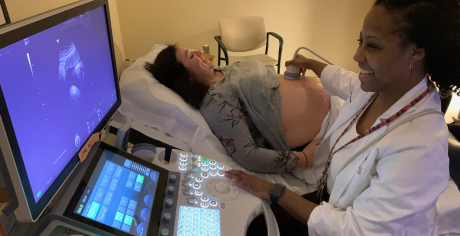
Duke High-Risk Obstetrics Clinic, located within Duke Perinatal Consultants of Durham and Fetal Diagnostic Center, recently added cardiology services to the lineup of specialties. This addition establishes Duke’s first multispecialty clinic for high-risk pregnancies.
The groundbreaking model of care was spearheaded by the Division of Maternal-Fetal Medicine within the Department of Obstetrics and Gynecology, with the goal to improve the quality of care available and convenient access for Duke’s high-risk obstetrical patients—a patient base largely seen by the same specialty providers, all of which traditionally practiced in different physical locations.
“Many high-risk pregnancies have complications that require care from multiple sub-specialists, such as hematologists (for managing blood disorders), endocrinologists (to manage pre-gestational diabetes and complex endocrine disorders), cardiologists (for maternal and/or fetal cardiac disorders), and anesthesiologists (for complex deliveries), among others,” says Brenna Hughes, MD, MSc, Division Chief of Maternal-Fetal Medicine. “The traditional model of referring patients out to other specialty clinics can be problematic because it requires additional travel and more cross-clinical communication—both of which can create hurdles for patients and providers.”
Prior to implementing the new model of care, Alice Cooper, OGNP, RNC, Medical Director for Women’s Ambulatory Services, had seen an increase in the rate of no-shows when high-risk patients were referred to other specialties. Cooper and a team of colleagues set out to determine the cause and discovered that difficult parking, long walks or access problems were the drivers. Not only were these issues leading to no-shows, but they were also tied to a decrease in patient satisfaction.
“The goal was to improve patient safety and satisfaction by providing these services in one convenient location, without competing with existing specialty services,” says Cooper. “The idea was well-received by patients and with our specialist colleagues with whom most of the crossover occurred, empowering us to bring the vision to life.”